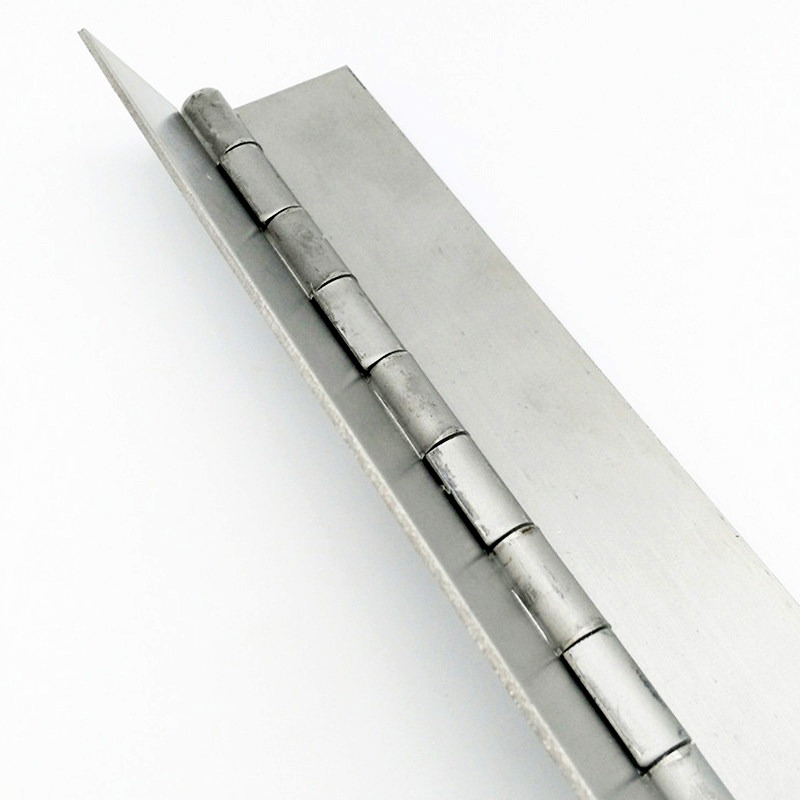Aerospace hinges play a pivotal role in the complex machinery and structures of the aerospace industry. These specially designed components provide seamless movement, stability, and security to various aircraft systems. This article will delve into the world of aerospace hinges, exploring their definition and highlighting their crucial importance within the aerospace industry.
Types of Aerospace Hinges
- Continuous Hinges:
Continuous hinges are robust, elongated hinges that span the entire length of a structure, enabling smooth and uninterrupted rotation. These hinges find extensive applications in the aerospace industry, such as cabin doors, access panels, and control surfaces. The continuous design provides increased load-bearing capacity and enhanced structural integrity. However, one must consider the added weight and potential limitations in angular movement when using continuous hinges. - Piano Hinges:
Piano hinges, also known as continuous hinges, are slender and elongated hinges that offer strength and durability. They are widely employed in aircraft structures, especially for attaching control surfaces and movable partitions. Piano hinges are typically constructed using lightweight yet sturdy materials such as aluminum or stainless steel. Their design allows for consistent and reliable rotation, ensuring smooth and precise movement within the aircraft. - Butt Hinges:
Butt hinges are commonly used in aerospace applications, providing stability and strength for various components such as doors, panels, and access points. These hinges consist of two leaf plates joined by a pin, enabling rotational movement. Butt hinges are versatile and can be customized to meet specific design requirements. They offer exceptional load-bearing capabilities, making them ideal for heavy-duty applications in the aerospace industry.

Aerospace Hinge Materials
- Aluminum Hinges:
Aluminum hinges are highly favored in the aerospace industry due to their exceptional characteristics and benefits. The lightweight nature of aluminum makes it an ideal material choice, reducing overall weight while maintaining structural integrity. Additionally, aluminum exhibits excellent corrosion resistance and durability, ensuring longevity and reliability in demanding aerospace environments. - Steel Hinges:
Steel hinges are renowned for their strength and load-bearing capabilities, making them suitable for heavy-duty aerospace components. These hinges are commonly used in areas where high structural integrity and durability are required. However, when utilizing steel hinges, it is essential to consider factors such as weight implications and the potential for increased maintenance due to susceptibility to corrosion. - Composite Hinges:
Composite hinges offer a unique set of advantages and challenges in the aerospace industry. These hinges are crafted using composite materials, such as carbon fiber-reinforced polymers. Composite hinges provide significant weight reduction without compromising strength and performance. However, challenges such as material compatibility, manufacturing complexities, and cost considerations need to be addressed when incorporating composite hinges into aerospace applications.

Design Considerations for Aerospace Hinges
- Load Capacity and Stress Analysis:
Accurate load capacity assessment is paramount when designing aerospace hinges. Understanding the expected forces and stresses the hinge will endure enables engineers to select the appropriate hinge type, size, and material. Utilizing stress analysis techniques like finite element analysis (FEA) ensures optimal hinge design and helps identify potential failure points, allowing for necessary design improvements. - Installation and Mounting:
Proper hinge installation techniques are critical for ensuring optimal performance and longevity. The selection of suitable mounting options, such as screws or rivets, and considering factors like alignment and precision requirements during installation are essential. Adequate attention to installation details reduces the risk of misalignment, misplacement, or premature wear, ensuring the hinge functions reliably throughout its service life.
Hinge Testing and Certification
- Regulatory Standards and Compliance:
The aerospace industry adheres to strict regulatory standards set by governing bodies such as the Federal Aviation Administration (FAA) and European Union Aviation Safety Agency (EASA). Hinge manufacturers must meet specific certification requirements and standards to ensure compliance with safety regulations. Adhering to these standards is crucial for maintaining the highest levels of safety and reliability in the aerospace industry. - Performance and Reliability Testing:
Hinges undergo rigorous testing procedures to evaluate their performance and reliability under various conditions. Testing methods such as cyclic fatigue testing, load testing, and environmental testing simulate real-world scenarios to validate hinge functionality and durability. Factors like load capacity, wear resistance, and environmental resistance are evaluated to ensure hinges meet the stringent requirements of the aerospace industry.

Maintenance and Inspection of Aerospace Hinges
- Preventive Maintenance:
Regular inspections are essential to ensure the proper functioning of aerospace hinges. Implementing preventive maintenance practices, such as lubrication and corrosion prevention, helps extend the hinge’s lifespan and maintain optimal performance. Following manufacturer recommendations and industry best practices for hinge maintenance minimizes the risk of unexpected failures and maximizes safety and reliability. - Failure Analysis and Troubleshooting:
Identifying common hinge failures and implementing effective troubleshooting techniques are critical for maintaining uninterrupted operations. Regular inspections aid in identifying signs of wear, misalignment, or damage. Prompt action and adherence to proper repair and replacement considerations prevent potential safety hazards and minimize downtime in the aerospace industry.
Conclusion:
Aerospace hinges are integral components that contribute to the functionality, safety, and reliability of aircraft structures and systems. Understanding the different types of hinges, materials, design considerations, testing procedures, and maintenance practices is crucial for engineers, manufacturers, and maintenance personnel in the aerospace industry. By prioritizing hinge quality, compliance with regulatory standards, and proactive maintenance, the aerospace industry can continue to innovate and ensure the highest standards of safety and performance in hinge technology.




